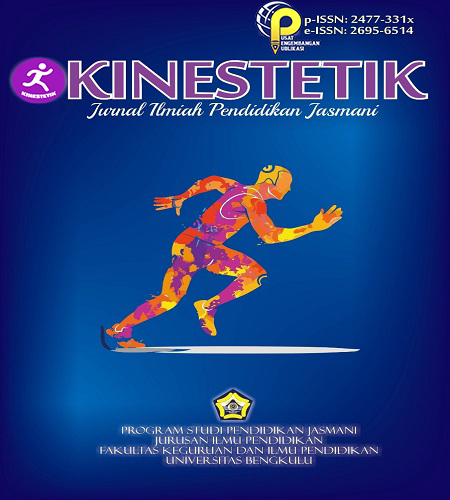Main Article Content
Abstract
Keywords
Article Details
- Authors retain copyright and grant the journal right of first publication with the work simultaneously licensed under a Creative Commons Attribution-ShareAlike 4.0 (CC BY-SA) that allows others to share the work with an acknowledgement of the work's authorship and initial publication in this journal.
- Authors are able to enter into separate, additional contractual arrangements for the non-exclusive distribution of the journal's published version of the work (e.g., post it to an institutional repository or publish it in a book), with an acknowledgement of its initial publication in this journal.
- Authors are permitted and encouraged to post their work online (e.g., in institutional repositories or on their website) prior to and during the submission process, as it can lead to productive exchanges, as well as earlier and greater citation of published work (See The Effect of Open Access).
- This work is licensed under a Creative Commons Attribution-ShareAlike 4.0 International License.
References
- Agustin MA, (2019), Integrating Emotional Intelligence into Sports Activities, http://repository.upi.edu/.
- Borg & Gall, 2007. Education Research. New York: Allyn and Bacon.
- Bean, C., & Forneris, T. (2016). Examining the Importance of Intentionally
- Burhaein, E. (2017). Aktivitas fisik olahraga untuk pertumbuhan dan perkembangan siswa SD. Indonesian Journal of Primary Education, 1(1), 51-58. Structuring the Youth Sport Context to Facilitate Positive Youth, 3200 (June), 0–16. https://doi.org/10.1080/10413200.2016.1164764.
- Chinkov, A., & Holt, N. (2016). Implicit transfer of life skills through participation in Brazilian jiu-jitsu. Journal of Applied Sport Psychology, 28, 139–153. https://doi.org/10.1080/10413 200.2015.1086447.
- Cronin, LD, & Allen, J. (2017). Development and initial validation of the Life Skills Scale for Sport. Psychology of Sport and Exercise, 28, 105–119.
- Forneris, Tanya, Martin Camiré, and Pierre Trudel. 2012. “The Development of Life Skills and Values in High School Sport: Is There a Gap between Stakeholder's Expectations and Perceived Experiences?” International Journal of Sport and Exercise Psychology 10(1): 9–23.
- Gould, D., & Carson, S. (2008a). International Review of Sport and Exercise Psychology Life skills development through sport : current status and future directions, (March 2013), 37–41. https://doi.org/10.1080/17509840701834573.
- Gould, D., & Carson, S. (2008b). Life skills development through sport: current status and future directions. International Review of Sport and Exercise Psychology, 1(1), 58–78. https://doi.org/10.1080/17509840701834573.
- Kendellen, K. (2016). Coaching for Positive Youth Development in High School Sport, (March). https://doi.org/10.4324/9781315709499-11.
- Pierce, S., Gould, D., & Camiré, M. (2017). Definition and model of life skills transfer. International Review of Sport and Exercise Psychology, 10(1), 186–211 https://doi.org/10.1080/1750984X.2016.1199727.
- Rohmanasari, R., Ma'mun, A., & Muhtar, T. (2018). Dampak Kegiatan Ekstrakurikuler terhadap Perkembangan Life Skills Siswa Sekolah Menengah Atas. Jurnal Penelitian Pendidikan, 18(3), 371-382.
- Sugiyono. (2017). Quantitative, Qualitative, and R&D Research Methods. Bandung : Alfabeta, CV.
- Schneider, M., Dunn, A., & Cooper, D. (2009). Affect, exercise, and physical activity among healthy teenagers. Journal of Sport and Exercise Psychology, 31(6), 706–723.
References
Agustin MA, (2019), Integrating Emotional Intelligence into Sports Activities, http://repository.upi.edu/.
Borg & Gall, 2007. Education Research. New York: Allyn and Bacon.
Bean, C., & Forneris, T. (2016). Examining the Importance of Intentionally
Burhaein, E. (2017). Aktivitas fisik olahraga untuk pertumbuhan dan perkembangan siswa SD. Indonesian Journal of Primary Education, 1(1), 51-58. Structuring the Youth Sport Context to Facilitate Positive Youth, 3200 (June), 0–16. https://doi.org/10.1080/10413200.2016.1164764.
Chinkov, A., & Holt, N. (2016). Implicit transfer of life skills through participation in Brazilian jiu-jitsu. Journal of Applied Sport Psychology, 28, 139–153. https://doi.org/10.1080/10413 200.2015.1086447.
Cronin, LD, & Allen, J. (2017). Development and initial validation of the Life Skills Scale for Sport. Psychology of Sport and Exercise, 28, 105–119.
Forneris, Tanya, Martin Camiré, and Pierre Trudel. 2012. “The Development of Life Skills and Values in High School Sport: Is There a Gap between Stakeholder's Expectations and Perceived Experiences?” International Journal of Sport and Exercise Psychology 10(1): 9–23.
Gould, D., & Carson, S. (2008a). International Review of Sport and Exercise Psychology Life skills development through sport : current status and future directions, (March 2013), 37–41. https://doi.org/10.1080/17509840701834573.
Gould, D., & Carson, S. (2008b). Life skills development through sport: current status and future directions. International Review of Sport and Exercise Psychology, 1(1), 58–78. https://doi.org/10.1080/17509840701834573.
Kendellen, K. (2016). Coaching for Positive Youth Development in High School Sport, (March). https://doi.org/10.4324/9781315709499-11.
Pierce, S., Gould, D., & Camiré, M. (2017). Definition and model of life skills transfer. International Review of Sport and Exercise Psychology, 10(1), 186–211 https://doi.org/10.1080/1750984X.2016.1199727.
Rohmanasari, R., Ma'mun, A., & Muhtar, T. (2018). Dampak Kegiatan Ekstrakurikuler terhadap Perkembangan Life Skills Siswa Sekolah Menengah Atas. Jurnal Penelitian Pendidikan, 18(3), 371-382.
Sugiyono. (2017). Quantitative, Qualitative, and R&D Research Methods. Bandung : Alfabeta, CV.
Schneider, M., Dunn, A., & Cooper, D. (2009). Affect, exercise, and physical activity among healthy teenagers. Journal of Sport and Exercise Psychology, 31(6), 706–723.
